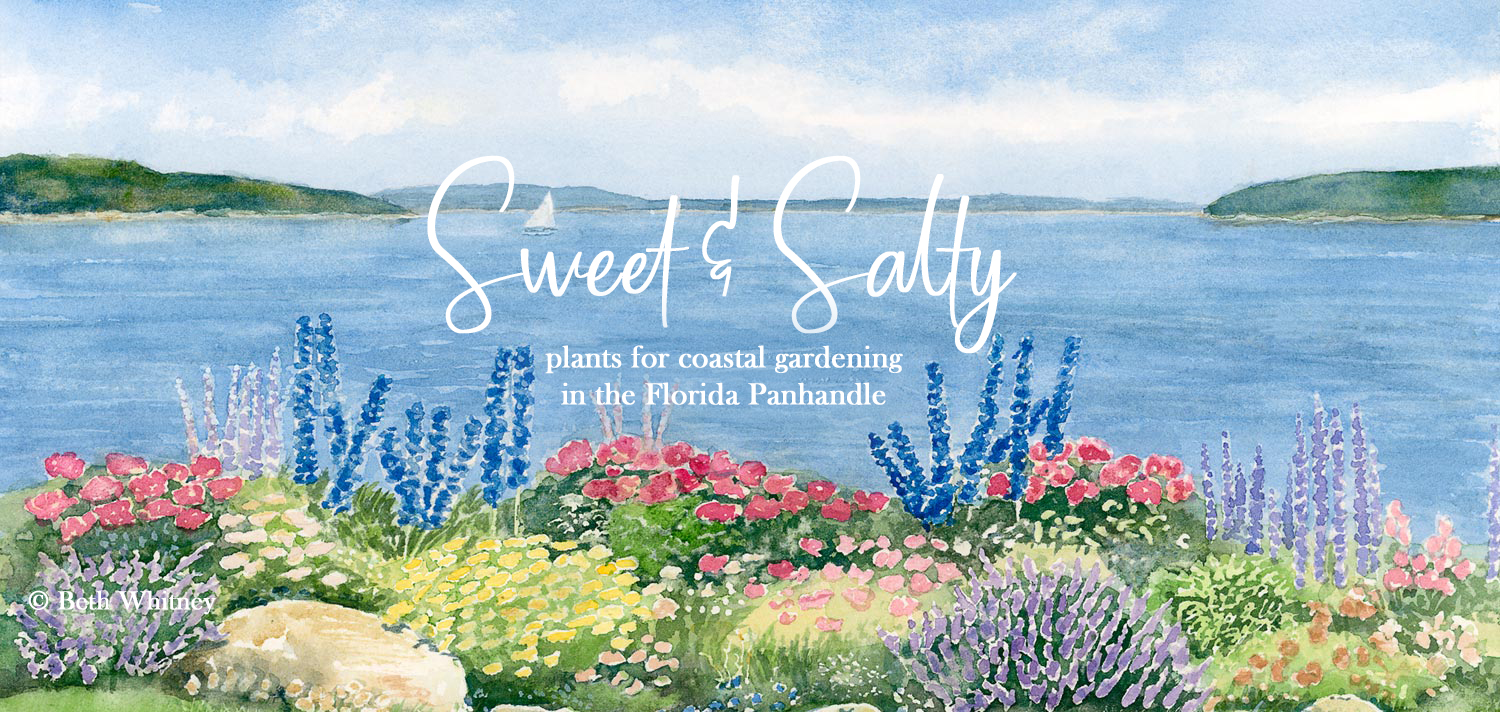
Sweet and Salty: plants for coastal gardening in the Florida Panhandle
Picking the right plant for the right place is the cornerstone of successful gardening. The more challenging the environment, the more important the proper plant section becomes. Coastal gardens are particularly challenging due to salt spray in the air, salt in the groundwater, sandy soil with poor water and nutrient holding ability, as well as intense heat and windy weather. With more people making homes along the Gulf Coast, it is increasingly important that we maintain vibrant, healthy landscapes near the water. Lush coastal landscapes can help reduce erosion, mitigate storm damage, provide food and habitat for wildlife, and filter water before it gets to the ocean.
While proper plant choice is essential to a successful coastal garden, proper care is equally important. Follow these guidelines when gardening near the coast:
- Amend sandy soil with LOTS of compost at the time of planting to improve its nutrient and water holding capacity. Gypsum may also be added to sandy soil to improve its nutrient holding capacity without affecting the pH.
- Water deeply with fresh water to flush the accumulated salt from the surface layers of soil.
- Create windbreaks around the perimeter of your garden to protect the plants inside from salt spray and drying wind. These can be living hedges or structures. If you create living windbreaks, be sure to use only highly salt tolerant plants to create the windbreak as they will be exposed to large amounts of salt spray and wind. Windbreaks are one of the best ways to protect your coastal garden.
- Avoid high analysis fertilizer which will add even more salt to your soil. Use only low analysis fertilizers (ones with smaller numbers for N-P-K) and slow release fertilizer. This will also prevent nutrient runoff into the ocean. Focus on organic fertilizer and compost. Compost can be added on top of the soil, around your plants, each year to fertilize and build soil.
- Use raised beds to grow more sensitive flowers, herbs, and veggies. Bringing in good quality soil will give the gardener greater control over the growing conditions. Wooden boxes are lovely, but large mounds or swales are easier and work just as well.
The following list of salt tolerant plants has been specifically created for North Florida gardeners, using plants that are generally available from local sources and well adapted to our climate. There is often disagreement about just how salt tolerant a specific plant may be. For that reason we have noted “highly salt tolerant” choices (with an asterisk) only if they are listed as such from numerous reliable sources. The following selections has been compiled from many university recommendations, select trusted nursery resources, and first hand observations of coastal planting in the Florida Panhandle.
This article was written by Jonathan Burns (Tallahassee Nurseries Outdoor Manager, FNGLA Florida Certified Horticulture Professional) using information published by the University of Florida, other Universities, trusted nursery resources, and combined with years of personal observations growing in the Tallahassee area.
* Highly Salt Tolerant
(N) Native
(W) Notable Wildlife Value
Trees
Large Growing
- Arizona Cypress
- Bald Cypress (N,W)
- *Canary Island Date Palm
- Dahoon Holly (N,W)
- Drake Elm
- Ginkgo
- Holly Hybrids: Savannah, East Palatka, Eagleston, Foster (N,W)
- Italian Cypress
- Japanese Cedar / Cryptomeria
- *Live Oak (N,W)
- Mulberry (N,W)
- Native Persimmon (N,W)
- Native Red Maple (N)
- *Red Cedar (N,W)
- River Birch (N)
- *Sabal Palm (N,W)
- *Sand Live Oak (N,W)
- *Slash Pine (N,W)
- *Southern Magnolia (N,W)
- Sugarberry (N,W)
- Sweet Bay Magnolia (N,W)
- Tulip Poplar (N,W)
- *Washington Palm aka Mexian Fan Palm
Small Growing
- Banana
- Bamboo, all species in the genus Bambusa
- Chickasaw Plum (N,W)
- Crape Myrtle
- Edible Olive (W)
- Eucalyptus
- Japanese Persimmon (W)
- Loquat (W)
- Pindo Palm (W)
- Red Buckeye (N,W)
- *Sea Breeze Bamboo
- Vitex / Chaste Tree (W)
Shrubs and Grasses
Large Growing (Over 6’)
- Banana Shrub
- *Bottlebrush (W)
- Camellia: most types & varieties
- Citrus: most varieties and roostocks
- *Fig: most edible varieties (W)
- *Giant Indian Hawthorn: Rosalinda, Majestic Beauty
- Hinoki Cypress
- Hollies: Dwarf Burford (W), Nellie R. Stevens (W), Elizabeth Coleman (W), Oakleaf (W)
- *Junipers: Blue Point, Torulosa, Hollywood, Hetzi Columnaris
- King Sago
- Ocala Anise (N)
- *Pampas Grass
- Pineapple Guava (W)
- *Pittosporum: Green, Variegated
- Podocarpus (W)
- Rose of Sharon / Althea (W)
- Sunshine Ligustrum
- Tea Olive
- Viburnum: Sweet, Spring Bouquet, Walter’s (N,W), Arrowwood (N,W), Rusty Black Haw (N,W)
- Wax Leaf Ligustrum
- *Wax Myrtle (N,W)
- *Weeping Yaupon Holly (N,W)
- Windmill Palm
- *Yaupon Holly (N,W)
Compact Growing (Under 6’)
- Abelia: Rose Creek (W), Canyon Creek (W), Hopley, Kaleidoscope
- *Agave (N,W)
- Aucuba
- Azalea indica: Formosa, George Taber, GG Gerbing, Southern Charm, Red Formosa
- Bambina Compact Pineapple Guava
- Beauty Berry (N,W)
- Boxwood
- Butterfly Bush / Buddleia (W)
- Camellia: Shi Shi Gashira and other compact varieties
- Cast Iron
- Clethra / Summersweet (N,W)
- *Coontie (N)
- Dwarf Hinoki Cypress
- Dwarf Japanese Cedar / Cryptomeria
- Dwarf Podocarpus
- Dwarf Palmetto (N,W)
- Dwarf Yaupon (N)
- Fakahatchee Grass (N,W)
- Fatsia
- Florida Anise (N,W)
- Fountain Grass / Pennisetum
- Gardenia
- *Harland Boxwood
- Hesperaloe (W)
- Hollies: Carissa, Chinese Holly (W)
- Hydrangea: classic mophead varieties
- *Indian Hawthorn: Eleanor Taber, Spring Sonata
- Lemongrass
- *Lomandra Grass: Breeze, Katrinus, Platinum Beauty, Tropic Belle
- Miscanthus Grass: Adagio
- *Muhly Grass (N,W)
- Needle Palm (N,W)
- *Pittosporum: Compact, Mojo
- *Prickly Pear
- Roses: most types
- *Rosemary
- *Sand Cordgrass (N)
- *Saw Palmetto (N,W)
- Selloum Philodendron
- Switchgrass / Panicum (N,W)
- Umbrella Palm / Cyperus
- Viburnum: Mrs Schiller’s Delight (N,W)
- Yesterday Today & Tomorrow Plant / Brunfelsia
- *Yucca: Color Guard, Magenta Magic (N,W), Blue Sentry, Filamentosa (N,W)
Flowers and Color
Warm Season Interest
- African Iris
- Agapanthus
- Agastache (W)
- Ageratum (N,W)
- Alternanthera
- Allamanda
- *Aloe
- Amaryllis
- Angel’s Trumpet / Brugmansia
- Artemisia
- Baptisia (N, W)
- *Blue Daze
- *Bougainvillea
- Bulbine
- *Bush Daisy
- Butterfly Ginger / Hedychium (W)
- *Cape Honeysuckle (W)
- *Canna Lily
- Celosia
- Cigar Plant (W)
- *Coleus
- Coral Bean (N,W)
- *Coreopsis (N,W)
- Cosmos
- Crinum: most species and varieties
- *Daylily
- *Dune Sunflower (N,W)
- Duranta (W)
- Euphorbia
- Firebush (N,W)
- Firecracker / Russelia (W)
- Flax Lily / Dianella
- *Gaillardia (N,W)
- Gazania
- *Geranium
- Gerber Daisy
- Gomphrena
- *Gaura / Whirling Butterflies (W)
- Hibiscus: most annual and perennial varieties (W), including native species (N, W)
- *Impatiens: Sunpatiens, New Guinea, Imara Series, Beacon Series
- Ixora
- *Lantana (W)
- Louisiana Iris (N)
- Mandevilla
- *Marigold
- Mexican Heather (W)
- Milkweed / Asclepias (~N,W)
- Mint: most types
- Nicotiana
- Oyster Plant
- Passionvine (N,W)
- Penta (W)
- *Petunia
- Pinecone Ginger
- Plumbago (W)
- *Purslane & Portulaca
- Red Hot Poker (W)
- Rudbeckia / Black-eyed Susan (N,W)
- Ruellia
- Russian Sage
- *Salvia: most perennial and annual species and varieties (W)
- Setcreasea / Purple Queen
- Sedum & Succulents
- Shell Ginger
- Shrimp Plant (W)
- Spider Lily / Hemerocallis (N)
- Squash: most edible varieties
- *Society Garlic
- Thyme
- Thryallis
- Tibouchina
- Turk’s Cap (W)
- *Verbena
- *Wax Begonia
- *Vinca
- Yarrow (W)
- *Zinnia (W)
Cool Season Interest
- Alyssum
- *Cabbage: edible and ornamental varieties
- Calendula
- *Dianthus
- *Dusty Miller
- *Kale: edible and ornamental varieties
- Lobelia
- *Snapdragon
Groundcovers & Vines
- *Asiatic Jasmine
- Carolina Jessamine (N)
- *Star Jasmine
- Coral Honeysuckle (N,W)
- *Creeping Fig
- *Dwarf Mondo Grass
- Foxtail Fern
- Holly Fern
- *Junipers: Blue Paciifc, Golden Pacific, Parsonii, Dwarf Japanese, Grey Owl
- *Liriope
- *Mondo Grass
- Native Wisteria (N)
- *Perennial Peanut
- *Sunshine Mimosa (N,W)
- Trumpet Creeper (N,W)
We will carry over 90% of these plants at some point in a calendar year. For specific plant ability, give us a call at 850-385-2162 or send us an email via our contact form HERE

